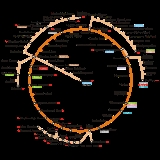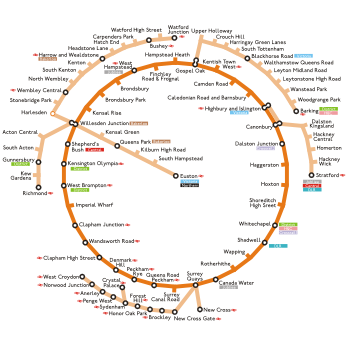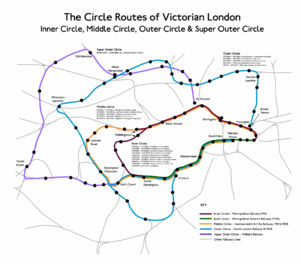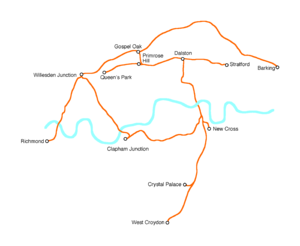
Orbirail
Encyclopedia

London
London is the capital city of :England and the :United Kingdom, the largest metropolitan area in the United Kingdom, and the largest urban zone in the European Union by most measures. Located on the River Thames, London has been a major settlement for two millennia, its history going back to its...
. It would involve connecting the extended North London Line
North London Line
The North London Line is a railway line which passes through the inner suburbs of north London, England. Its route is a rough semicircle from the south west to the north east, avoiding central London. The line is owned and maintained by Network Rail...
, East London Line
East London Line
The East London Line is a London Overground line which runs north to south through the East End, Docklands and South areas of London.Built in 1869 by the East London Railway Company, which reused the Thames Tunnel, originally intended for horse-drawn carriages, the line became part of the London...
, the Inner South London Line and the West London Line
West London Line
The West London Line is a short railway in inner West London which links lines at in the south to lines near Willesden Junction in the north. It has always been an important cross-London link especially for freight services...
, possibly including the Gospel Oak to Barking Line
Gospel Oak to Barking line
The Gospel Oak – Barking Line is a railway line in north and east London which connects Gospel Oak in North London and Barking in East London as part of the London Overground network. It is sometimes known as the Goblin , although this is a nickname rather than an official title...
. The combined line would orbit London in Zone 2
Travelcard Zone 2
Fare zone 2 is an inner zone of Transport for London's zonal fare system used for calculating the price of tickets for travel on the London Underground, London Overground, Docklands Light Railway and, since 2007, on National Rail services.-Background:...
, Zone 3
Travelcard Zone 3
Fare zone 3 is a zone of Transport for London's zonal fare system used for calculating the price of tickets for travel on the London Underground, London Overground, Docklands Light Railway and, since 2007, on National Rail services...
and (possibly) Zone 4
Travelcard Zone 4
Fare zone 4 is a zone of Transport for London's zonal fare system used for calculating the price of tickets for travel on the London Underground, London Overground, Docklands Light Railway and, since 2007, on National Rail services...
. It is not to be confused with London's existing circular railway, the Circle line of the London Underground
London Underground
The London Underground is a rapid transit system serving a large part of Greater London and some parts of Buckinghamshire, Hertfordshire and Essex in England...
.
Status
Until recently Orbirail has had no official status as a planned project. However, Transport for LondonTransport for London
Transport for London is the local government body responsible for most aspects of the transport system in Greater London in England. Its role is to implement the transport strategy and to manage transport services across London...
's London Overground
London Overground
London Overground is a suburban rail network in London and Hertfordshire. It has been operated by London Overground Rail Operations since 2007 as part of the National Rail network, under the franchise control and branding of Transport for London...
when completed will achieve substantially the same objective. On 12 February 2009, Mayor Boris Johnson and the then Transport Secretary Geoff Hoon announced £75 Million to fund the Southern extension of the Overground network between Surrey Quays and Clapham Junction as part of the East London line extension
East London line extension
The East London line extension project is a British railway engineering project in London, managed by Transport for London. The project involves extending the East London Line and making it part of the mainline London Overground network...
, creating the final connection of an orbital railway for London to be completed in time for the 2012 Olympic Games. However, the timeline now published by TfL states that while construction of the East London Line Extension will be completed by around that time, the line will not open until late 2012, well after the Olympics and Paralympics.
History of orbital railways in London

The first orbital rail service was the inner Circle line, which was operated over the central sections of the Metropolitan line
Metropolitan Line
The Metropolitan line is part of the London Underground. It is coloured in Transport for London's Corporate Magenta on the Tube map and in other branding. It was the first underground railway in the world, opening as the Metropolitan Railway on 10 January 1863...
and District line
District Line
The District line is a line of the London Underground, coloured green on the Tube map. It is a "sub-surface" line, running through the central area in shallow cut-and-cover tunnels. It is the busiest of the sub-surface lines. Out of the 60 stations served, 25 are underground...
. This linked most of the mainline stations and was a commercial success.
The success of the Inner Circle led to the operation of a number of other semi-orbital routes within the capital, over existing main line routes and sections of the MR's and MDR's Inner Circle tracks:
- Middle CircleMiddle CircleThe Middle Circle was a railway route in London which operated in the late 19th and early 20th centuries over tracks which are now mainly part of the London Underground...
- AldgateAldgate tube stationAldgate tube station is a London Underground station located at Aldgate in the City of London.The station is on the Circle Line between Tower Hill and Liverpool Street. It is also the eastern terminus of the Metropolitan Line...
to Mansion HouseMansion House tube stationMansion House is a London Underground station in the City of London, near Mansion House . It is a sub-surface station served by trains on the Circle and District Lines. It is between Blackfriars and Cannon Street stations. The station is located at the junction of Queen Victoria Street and Cannon...
via Addison Road (now Kensington OlympiaKensington (Olympia) stationKensington station is a station in West London managed and served by London Overground and also served by Southern and London Underground. It is in Travelcard Zone 2...
) - Outer CircleOuter Circle (London)The Outer Circle was a railway route in London operated in the late 19th and early 20th centuries over tracks which are now mainly owned by Network Rail but include parts of the London Underground...
- Broad Street to Mansion House via Willesden JunctionWillesden Junction stationWillesden Junction station is a Network Rail station in Harlesden, northwest London, UK. It is served by both London Overground and the Bakerloo line of the London Underground.-History:The station developed on three contiguous sites:... - Super Outer Circle - St. PancrasSt Pancras railway stationSt Pancras railway station, also known as London St Pancras and since 2007 as St Pancras International, is a central London railway terminus celebrated for its Victorian architecture. The Grade I listed building stands on Euston Road in St Pancras, London Borough of Camden, between the...
to Earl's CourtEarl's Court tube stationEarl's Court tube station is a London Underground station in Earls Court. The station is located between Earls Court Road and Warwick Road . It is on the boundary of Travelcard Zone 1 and 2 and is in both zones....
via CricklewoodCricklewood railway stationCricklewood railway station is in the London Borough of Barnet in North London. The station lies on the north-south Midland Main Line where it crosses Cricklewood Lane. It is served by First Capital Connect services as part of the Thameslink service...
and South ActonSouth Acton railway stationSouth Acton railway station is in the London Borough of Ealing in South Acton, west London. It is on the North London Line, and the station and all trains serving it are operated by London Overground. It is in Travelcard Zone 3...
London was a much smaller city than it is now and most commercial activity was focused at the centre. These outer routes failed to attract the passenger numbers hoped for and were eventually cut-back or ended while other, more radial services on the lines continued.
Other semi-orbital routes fared little better. Throughout the 20th century London's railways operated on a radial model and the few remaining semi-orbital passenger routes withered with the lines used mainly for freight services. The National Rail network was privatised with radial franchises. Only the original inner Circle line enjoyed success.
Throughout the 20th century London expanded both in size and population and employment ceased to be as heavily concentrated in the centre. Many more people were travelling through central London by Underground and many of them were only travelling in on one radial route so that they could travel out again on another. Congestion increased and additional Underground lines were built at great expense.
It was at this point that some suggested reviving and expanding the semi-orbital routes. The reasoning was that these routes could relieve the some of the load on central London in a much more cost effective way than the building of new tube lines. People who were travelling via central London could be provided with alternative routes. The idea coalesced around the suggested name "Orbirail", and it was even suggested that a fully orbital route could be operated, something that the outer Circle lines never quite achieved. The idea won few friends in the National Rail network for commercial and operational reasons.

Transport for London
Transport for London is the local government body responsible for most aspects of the transport system in Greater London in England. Its role is to implement the transport strategy and to manage transport services across London...
as a single body with overall responsibility for transport in London. During Ken Livingstone
Ken Livingstone
Kenneth Robert "Ken" Livingstone is an English politician who is currently a member of the centrist to centre-left Labour Party...
's term as Mayor of London
Mayor of London
The Mayor of London is an elected politician who, along with the London Assembly of 25 members, is accountable for the strategic government of Greater London. Conservative Boris Johnson has held the position since 4 May 2008...
, TfL exploited the potential in the neglected peripheral rail routes and started to plan a complete orbital rail system by joining these routes together (albeit with no plan for a single fully orbital service). The new system eventually launched under the name London Overground
London Overground
London Overground is a suburban rail network in London and Hertfordshire. It has been operated by London Overground Rail Operations since 2007 as part of the National Rail network, under the franchise control and branding of Transport for London...
, and work continues to complete the orbital route as more lines are added to the system. The eventual London Overground network will cover a route which bears a striking resemblance to the Outer Circle line with the East London line extension
East London line extension
The East London line extension project is a British railway engineering project in London, managed by Transport for London. The project involves extending the East London Line and making it part of the mainline London Overground network...
and Inner South London Line being used to complete the loop.
Political support for the principle of Orbirail continued after the change of leadership following the London mayoral election, 2008
London mayoral election, 2008
The London mayoral election, 2008 for the office of Mayor of London was held on 1 May 2008 and was won by Conservative Party candidate Boris Johnson....
. During his election campaign, Boris Johnson
Boris Johnson
Alexander Boris de Pfeffel Johnson is a British journalist and Conservative Party politician, who has been the elected Mayor of London since 2008...
published a transport manifesto which highlighted the problems associated with orbital journeys around London:
The manifesto noted that 64% of journeys in outer London were made by cars or vans, and suggested that improved orbital public transport would help to reduce this figure, proposing a trial of orbital express bus
Transit bus
A transit bus , also known as a commuter bus, city bus, or public bus, is a bus used for short-distance public transport purposes...
routes linking key suburban rail terminals.
Arguments for and against
Orbirails proponents believe that it would be a relatively low-cost project, involving only a small amount of new track, some improvement to existing lines and an increase in train frequency. In return, the route would allow many people to make journeys without passing through Zone 1, thus relieving congestion on central London's railways.There are complications which could prevent these lines running as single fully orbital route. Orbital railways have an intrinsic timetabling robustness problem. The trains are constantly "in orbit" so there is little scope for "recovery time" if they are delayed. A single delay can have long lasting knock on effects and be much more disruptive than on a non-orbital railway. Recovery time can be created by timetabling for longer stops at some stations but this increases journey times and reduces train frequency. (For this reason, as of December 13, 2009, the Circle Line was replaced with a spiral shaped route with distinct endpoints.) In this light, it is hard to see a larger and more complicated orbital railway being approved.
An alternative to a single fully orbital route would be two or more semi-orbital routes that join to entirely encircle London. TfL's current London Overground plans seem to point in this direction.
An additional problem is poor interchange with many of the radial routes. The proposed route offers no interchange with the Great Western Main Line
Great Western Main Line
The Great Western Main Line is a main line railway in Great Britain that runs westwards from London Paddington station to the west of England and South Wales. The core Great Western Main Line runs from London Paddington to Temple Meads railway station in Bristol. A major branch of the Great...
, Chiltern Main Line
Chiltern Main Line
The Chiltern Main Line is an inter-urban, regional and commuter railway, part of the British railway system. It links London and Birmingham on a 112-mile route via the towns of High Wycombe, Banbury, and Leamington Spa...
, the East Coast Main Line
East Coast Main Line
The East Coast Main Line is a long electrified high-speed railway link between London, Peterborough, Doncaster, Wakefield, Leeds, York, Darlington, Newcastle and Edinburgh...
, the Great Eastern Main Line
Great Eastern Main Line
The Great Eastern Main Line is a 212 Kilometre major railway line of the British railway system, which connects Liverpool Street in the City of London with destinations in east London and the East of England, including Chelmsford, Colchester, Ipswich, Norwich and several coastal resorts such as...
or the London, Tilbury and Southend Railway
London, Tilbury and Southend Railway
The London, Tilbury and Southend Railway is an English railway line linking Fenchurch Street railway station in the City of London with northeast London and the entire length of the northern Thames Gateway area of southern Essex. It is currently known as the Essex Thameside Route by Network Rail...
. Only local services on the West Coast Main Line
West Coast Main Line
The West Coast Main Line is the busiest mixed-traffic railway route in Britain, being the country's most important rail backbone in terms of population served. Fast, long-distance inter-city passenger services are provided between London, the West Midlands, the North West, North Wales and the...
stop at Willesden Junction. It has similarly poor interchange with many London Underground
London Underground
The London Underground is a rapid transit system serving a large part of Greater London and some parts of Buckinghamshire, Hertfordshire and Essex in England...
lines. Poor interchange options are a general problem with most of London's older railways, which were built by competing private companies in the 19th century before the need for a coherent and integrated transport network was understood.

